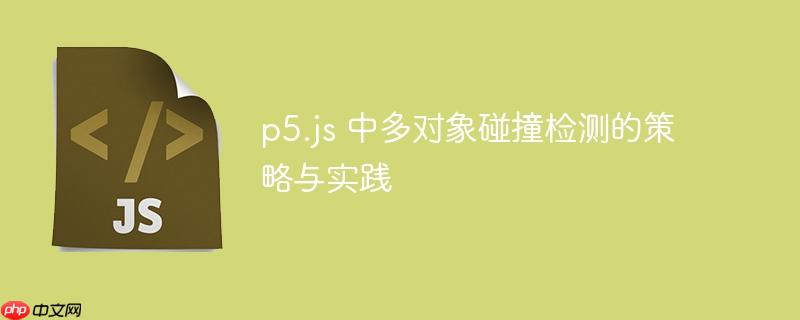
在开发基于p5.js的Pong类游戏时,当游戏引入多于一套的“球-挡板”组合(例如,达到一定分数后增加额外的球和挡板)时,开发者可能会遇到一个常见的问题:碰撞检测不再按预期工作。具体表现为,初始的球只能与初始的挡板发生碰撞,而新增的球或挡板无法与原有的对象进行碰撞,反之亦然。
究其原因,这通常不是p5.collide2d库本身的问题,而是游戏对象设计和碰撞检测逻辑实现方式的问题。原始代码中,一个名为Thing的类被用来同时封装了玩家挡板、对手挡板和球的状态及行为。在Thing类的collide()方法中,碰撞检测仅针对该Thing实例所“拥有”的挡板和球进行,即:
// 原始代码中的碰撞检测片段 hit = collideRectRect(30, this.y, 1, this.f, this.w, this.h, 10, 10);
这里的this.y代表当前Thing实例的玩家挡板Y坐标,this.w和this.h代表当前Thing实例的球坐标。这意味着每个Thing实例只负责检查“自己的”挡板与“自己的”球之间的碰撞。当游戏中存在多个Thing实例时,它们各自独立地进行检测,导致了不同实例所代表的球和挡板之间无法互相检测到碰撞。
问题的根源在于对游戏实体的抽象不够清晰。一个Thing实例不应该同时代表一个玩家挡板、一个对手挡板和一个球。这种混合的设计模式(也称为“上帝对象”或“多重职责”)导致了以下问题:
为了解决这个问题,我们需要重新设计游戏实体的结构,并调整碰撞检测的逻辑。
解决多对象碰撞检测问题的关键在于以下两点:
我们将原始的Thing类拆分为Paddle(挡板)类和Ball(球)类。
Paddle 类:
负责挡板的位置、尺寸、颜色和移动逻辑。可以添加一个isPlayer属性来区分玩家挡板和对手挡板。
class Paddle {
constructor(x, y, w, h, isPlayer = false) {
this.x = x;
this.y = y;
this.w = w;
this.h = h;
this.isPlayer = isPlayer; // 标识是否为玩家挡板
this.speed = 5; // 挡板移动速度
}
show() {
noStroke();
fill(255, 229, 236); // 挡板颜色
rect(this.x, this.y, this.w, this.h);
}
move(ballY = null) { // ballY 用于对手AI的跟踪
if (this.isPlayer) {
// 玩家挡板通过键盘控制
if (keyIsDown(DOWN_ARROW)) this.y += this.speed;
if (keyIsDown(UP_ARROW)) this.y -= this.speed;
this.y = constrain(this.y, 0, height - this.h); // 限制在画布内
} else {
// 对手挡板(AI)跟随球移动
if (ballY !== null) {
this.y = ballY - this.h / 2; // 简单AI:挡板中心对准球
this.y = constrain(this.y, 0, height - this.h); // 限制在画布内
}
}
}
}Ball 类:
负责球的位置、尺寸、颜色、速度和移动逻辑。
class Ball {
constructor(x, y, size, color) {
this.x = x;
this.y = y;
this.size = size;
this.color = color;
this.speedX = 5;
this.speedY = 5;
}
show() {
noStroke();
fill(this.color); // 球的颜色
rect(this.x, this.y, this.size, this.size);
}
move() {
this.x += this.speedX;
this.y += this.speedY;
// 球与上下墙壁的碰撞反弹
if (this.y < 0 || this.y > height - this.size) {
this.speedY *= -1;
}
}
// 检查球是否出界(未被挡住)
isOutOfBounds() {
return this.x < -this.size || this.x > width + this.size;
}
// 重置球的位置和速度
reset() {
this.x = width / 2;
this.y = height / 2;
this.speedX = 5;
this.speedY = 5;
}
}在setup()函数中,我们将创建独立的Paddle和Ball实例,并分别存储在paddles和balls数组中。在draw()函数中,我们将遍历这些数组,实现所有球与所有挡板之间的碰撞检测。
let paddles = []; // 存储所有挡板实例
let balls = []; // 存储所有球实例
let s = 0; // 游戏分数
let b = 0; // 最高分数
let mode; // 游戏模式
const STARTSCREEN = 1;
const GAME = 2;
function setup() {
createCanvas(600, 600);
rectMode(CORNER); // 设置矩形绘制模式为左上角
// 创建玩家挡板 (x=20, y=居中, 宽10, 高60)
paddles.push(new Paddle(20, height / 2 - 30, 10, 60, true));
// 创建对手挡板 (x=width-30, y=居中, 宽10, 高60)
paddles.push(new Paddle(width - 30, height / 2 - 30, 10, 60, false));
// 创建初始球 (白色)
balls.push(new Ball(width / 2, height / 2, 10, 'white'));
mode = STARTSCREEN; // 初始游戏模式
}
function draw() {
if (mode === STARTSCREEN) {
startScreen();
} else if (mode === GAME) {
game();
}
}
// 游戏开始画面(省略具体实现,与原代码类似)
function startScreen() {
background(255, 194, 209);
textAlign(CENTER);
textSize(33);
fill(255, 179, 198);
text("CLICK TO START", width / 2, height / 2 + 10);
fill(255, 229, 236);
text("HIGH SCORE: " + b, width / 2, height / 6);
textSize(50);
text("PONG PERFECT", width / 2, height / 6 * 4.75);
}
function mousePressed() {
if (mode === STARTSCREEN) {
mode = GAME; // 点击开始游戏
} else if (mode === GAME) {
// 游戏中的点击事件(如果需要)
}
}
function game() {
background(255, 194, 209);
// 绘制分数板和中线
rectMode(CENTER);
fill(255, 229, 236);
rect(width/2, height / 8, 100以上就是p5.js 中多对象碰撞检测的策略与实践的详细内容,更多请关注php中文网其它相关文章!

每个人都需要一台速度更快、更稳定的 PC。随着时间的推移,垃圾文件、旧注册表数据和不必要的后台进程会占用资源并降低性能。幸运的是,许多工具可以让 Windows 保持平稳运行。

Copyright 2014-2025 https://www.php.cn/ All Rights Reserved | php.cn | 湘ICP备2023035733号